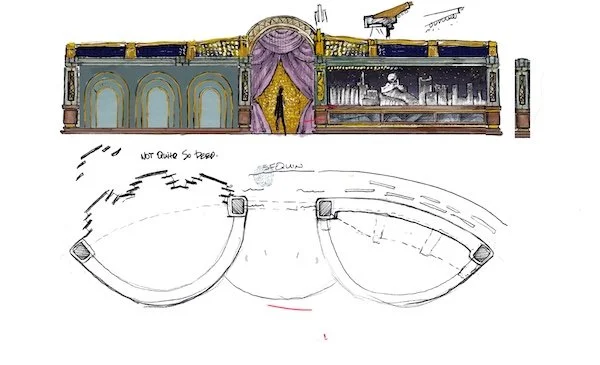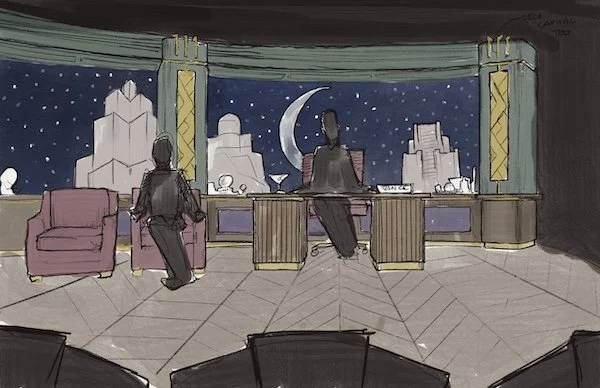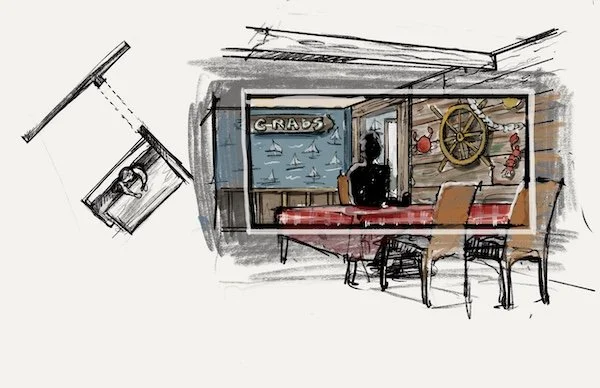From Brushstrokes to Backdrops: How Rob Tokarz Designed Hacks’ Cinematic World
Rob Tokarz is hands-on on set. Photos courtesy of Tokarz.
From scenic painting to shaping the visual world of HBO’s Hacks, Rob Tokarz’s path into production design wasn’t a straight line. He moved to Los Angeles thinking he would teach art, but then an unexpected film project led him to apply his art background to hit shows and films, including Heroes, Parks and Recreation, Ray Donovan, Ford v. Ferrari, and now Hacks.
Here, Tokarz shares how he went from fine art to Hollywood, what goes into the trickiest set designs on Hacks, and why you have to be an adrenaline junkie to love this work.
Tell us how you fell into this Hollywood career by accident.
I moved to L.A. to get an MFA in scenic painting, and my plan was to teach and focus on my fine art career. But in my second weekend at CalArts, a student needed help on a film set, and once I stepped onto that set, something just clicked. The chaos made sense to me. All the moving parts were exciting and strangely familiar.
I’m first-generation — my parents are Polish immigrants — and I didn’t grow up thinking of TV or film as something regular people made. Once I realized it was a real career, I was all in. I kept painting scenery for school, but every chance I got — weekends, summers — I was on set, learning how the industry worked.
Tokarz’s ideation process follows the line of an idea from sketch to model to set, as seen in these images.
As the head of production design, what do you do on a TV show like Hacks?
At its core, production design for TV is a blend of creative vision and logistics. You’re working with tight schedules, short timelines, and a lot of constraints. So you have to trust your instincts and move quickly.
My process usually starts with the script. I break it down, figure out what’s being shot on location versus on a stage, and begin mapping out what we’ll need to build or alter. From there, it’s about research, drawing, and assembling a plan with my team.
Because of my fine art background, I start with sketches. I think with my hands. Whether I’m in a van scouting or sitting in the office, I’m sketching out scenes, spaces, and visual ideas. Then my set designers and art director take those concepts and translate them into technical plans for construction. At the same time, I’m pulling wallpaper samples, choosing colors, and thinking about the emotional tone of each space.
I’ll present options to the director, often using everything from digital models to physical ones. I’ve even used augmented reality on my phone to walk people through a digital set on an empty soundstage. But at the end of the day, nothing beats building a model and seeing it in scale with your hands.
Tokarz begins scene design with a colorful sketch.
Do you have a specific entry point when you’re designing a set? A visual or emotional anchor?
It always starts with the drawing. If I’m not happy with how something looks on paper, I can’t move forward. Once I’ve nailed the look and feel, I start thinking through the practical needs: camera angles, blocking, the director’s style. Luckily, on Hacks, we have mostly the same directors in Lucia and Paul, and we’ve had the same DP, Adam Bricker, for a long time, so I know how they like to shoot. That helps me prioritize what the camera will really see and where I can put the most energy. But there can always be surprises and happy accidents.
How much of your career has been built through relationships?
A huge amount. Parks and Recreation was a great example. Morgan Sackett was the executive producer on that, and he’s also the executive producer on Hacks. That relationship spans 14 years even if we haven’t always been working together. Jennifer Lukehart and I have now done four seasons of television together (across two different shows). Jeanine Ringer, my art director and I used to play trivia together when we were coming up in the industry. That kind of familiarity and trust makes everything run smoother.
The industry is small, and your reputation travels. Especially when I was an art director, I became known as someone who could step into chaos and make sense of it. That’s a valuable skill and it goes back to that very first student film I helped out on. I still try to bring that same energy every day.
Tokarz’s trickest design element this season included producing these X’s on the fly. They do look heavy.
What’s one of the trickiest design elements you’ve had to pull off on Hacks this season?
At the end of season three, the character Jimmy is launching his own agency. We shot those scenes at the American Cement Building near MacArthur Park, a distinctive space with floor-to-ceiling windows and massive X-shaped concrete panels.
Originally, we were supposed to return to that building for season four, but due to logistical and financial reasons, it didn’t work out. We realized late in the game that we’d need to recreate the entire space on a stage.
That meant re-creating those massive concrete Xs — which are 3D and sculptural — without being able to measure them accurately in person, since they were unreachable from inside the space. One of my set designers, Xi Yang, built the 3D model, the other, Darcy Prevost, 3D printed them and built them into a physical white model to make sure it would all work. We then used a printed photo backing to replicate the view of downtown L.A. We had to design, approve, and build the whole thing in under four weeks. Normally, it would take twice that long.
It was intense, but when our line producer, Nate Young, saw the finished set and said, “This doesn’t look like a set at all,” I knew we pulled it off.
Do you have to be an adrenaline junkie to do this work?
A little, yeah. There’s a moment every season where you’re throwing everything together under extreme pressure, and then — boom! — the set is open, and the cameras are rolling. It’s wild but joyful. That energy fuels everything.
Join more than 30 leaders from top organizations, including Spotify, Disney, Shake Shack, NASA, Cannondale, Hearst, Flatiron Health, Roblox, Clay, Paramount, The Aspen Institute, and Target.








